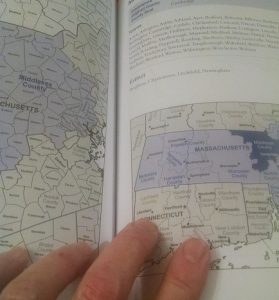When I first leafed through the Genealogist’s Handbook for New England Research, I thought there were too many maps. I know that sounds odd, but it was my initial reaction. There’s maps for every state showing all the counties within that state and there are actually two maps for every county in New England–one showing the relative position of that county within the state itself and another showing all the towns within that county. I fully understand the need for maps in research, both modern and contemporary to the problem at hand. Despite my love of maps, the number in the book seemed a little excessive.
But like anything else it is all about perspective.
Outside New England, research in local records is generally about the county. Town or township records are minimal, if they exist at all. That’s not the case in New England. In New England the town and the town’s records matter–just as much as those of the county.
As I started really working on my New England lines (especially  those from Massachusetts), I actually found the maps helpful. In Massachusetts, all of the state is contained within one town or another. That was a change of pace for someone raised in the rural Midwest where most of the county is not “in town.” I needed to know which towns bordered which other towns. People moved over time and knowing the proximity of the new location to the old was helpful. The maps were helpful with that.
those from Massachusetts), I actually found the maps helpful. In Massachusetts, all of the state is contained within one town or another. That was a change of pace for someone raised in the rural Midwest where most of the county is not “in town.” I needed to know which towns bordered which other towns. People moved over time and knowing the proximity of the new location to the old was helpful. The maps were helpful with that.
Of course I could find all the maps online, but sometimes it is easier to have everything in one book. And, if I need more specific geographic detail, there are online sources I can use. The maps in the guide are more than sufficient to give me geographic perspective.
We all bring our own background to our research. Where we live, where we grew up, our childhood experiences, own family of origin, our education, our job experience, and other “personal life events” all impact how we react to and interpret information. Sometimes when we research, particularly when that research works its way into time periods, locations, and cultural groups with which we are not familiar, we need to think about how our background may be causing us to interpret things in a way that is not quite correct.
It can be tempting to say that “this area is not different from where I’ve researched before.” There’s nothing I need to learn except the names of new locations and where the records are kept in this location. Nope.
That’s sometimes true when your research moves from one county to another within the same state. But not always true as there are often variations within counties contained in the same state. But when one’s research moves across the country, there are bound to be differences.
The more I work on my New England families, the more I use Genealogist’s Handbook for New England Research. It would have been easier if my relatives had stayed put and never moved, but that’s another story.

No responses yet